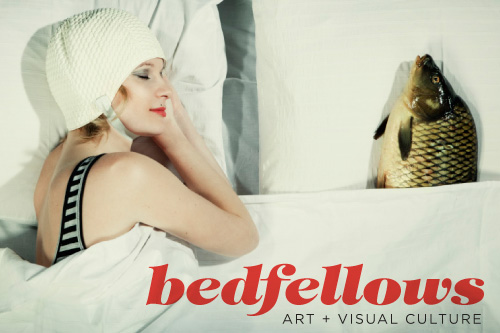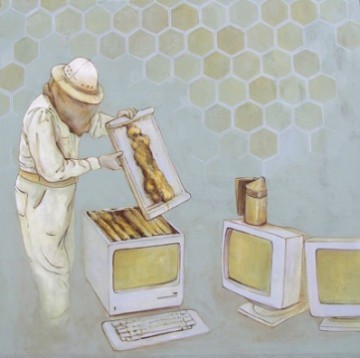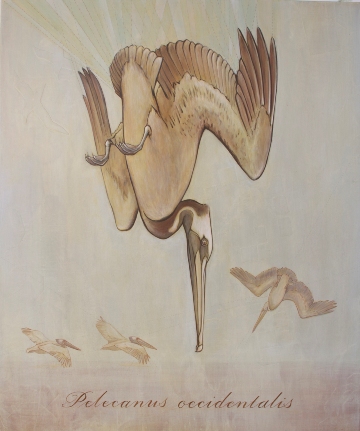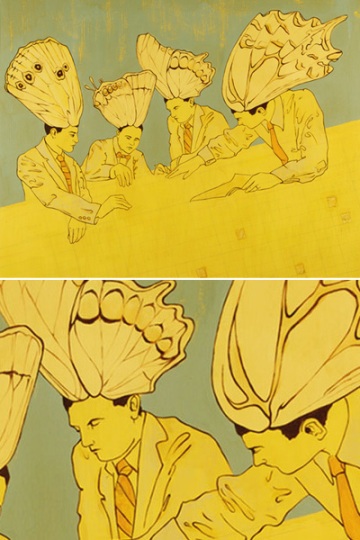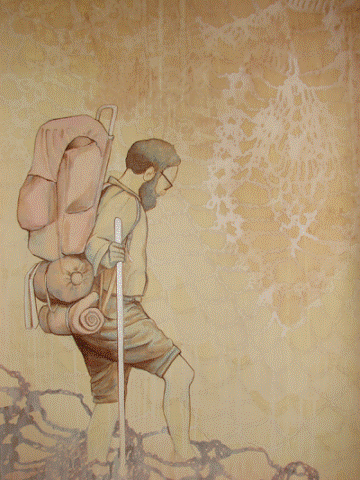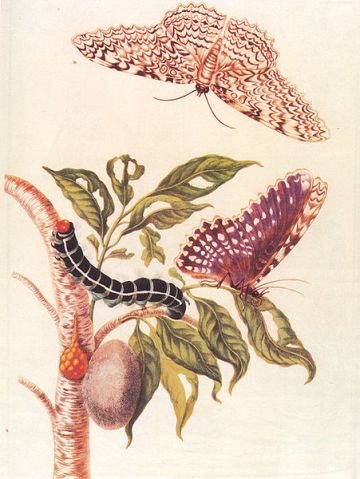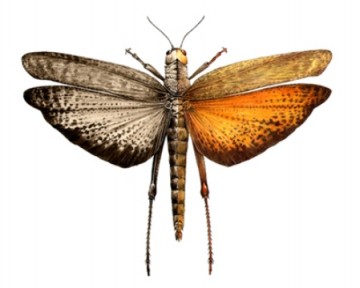
Alison Kendall, "1/2 and 1/2 Grasshopper," 2006. Half ink wash, half colored pencil on paper. Courtesy the artist.
Alison Kendall creates drawings and paintings in which viewers’ expectations are breached by dreamlike intruders. The San Francisco–based artist went to school for scientific illustration, learning to draw animals and plants for field guides and textbooks, to inspire understanding rather than wonder. While she continues to work part-time as an illustrator for scientific textbooks, in her own work she has consciously departed from the genre’s literal-mindedness.
Influenced by and derived from her background in scientific illustration, Kendall’s surreal tableaux are purposely incorrect; animals and objects are recognizable but appear in unlikely environments, as though misclassified. The artist skews linearity, leaning instead toward the possibilities of the unreal: butterfly wings protrude from men’s heads, while a beekeeper pulls frames not from a hive, but from a computer monitor.
Kendall’s hybrid practice—consisting of both “technical” and “artistic” illustration—exposes the way disciplinary constructs influence our expectations of an image and can determine which qualities we choose to value in it. Her work, and the work of other crossover scientific illustrators before her, advocates for a gray area between science and art, a paradigm in which an image can be both didactic and beautiful. It is a place where accuracy and aesthetics are not at odds and a thing is no less miraculous for its being explained.
Victoria Gannon: It’s interesting how the dominant mode of interaction with nature is to classify it and approach it in a technical way. I’ve never felt that way.
Alison Kendall: I’ve always been a nature person, but I was never really technical-minded. If you consider taxonomy to be technical, I’m at that level of technicality, but not beyond that. I don’t want to work in a laboratory.
It’s weird that the work that I do in ecology research involves classifying. I started working on this project when I graduated college, and still participate on a contract basis. It’s this large-scale coastal monitoring project in which we take the inventory of everything in the tide pools from Alaska to Mexico. I would sit in the tide pools for six or seven hours a day, identifying everything. And all the names just went in my brain. I’m going to be an old lady, and I’m going to remember all those names, because I don’t remember other things the way I remember them.
VG: Do you think you remembered them so well because you were physically in the environment?
AK: I think so; I always work best when I’m in an environment that’s hands on and I’m challenged and there’s pressure. In the tide pools, there’s so much pressure because the tide’s going to come in, and you have to get this work done.
VG: That’s such a different clock than most people follow.
AK: I did that work for years, and after awhile you know when the tide is turning. You can feel that something is happening; there’s a silence in the water and a stillness in the air and a quietness, and then it changes. There’s this push and feeling of this aggression coming toward you—this building up.
VG: Have you always drawn?
AK: When I was a kid I would draw, and people would say, “You’re a really nice drawer.” And in college, I would draw cross-sections, and people would tell me I was really good at it, but I wasn’t constantly making art. I always had friends who were making art and I was jealous and pissy and was like, It’s not fair you get to do that and you have money. I definitely felt the urge to make art.
VG: You did a program in scientific illustration at UC Santa Cruz. I’m familiar with MFA programs in fine art, but what did your program emphasize?
AK: At the time, you had to be a scientist first in order to get in, so all the people in the program were scientists. Now it’s moved to Cal State Monterey Bay, and they’re much more relaxed about the students, and you can have an art background and do it, which I think is really cool.
I struggled with some things in that program because it was so steeped in precision and tradition, and I was like, Why can’t I draw my eagle with its head falling off? Because its head did fall off. People would wear plastic gloves to not get sweat marks on their paper, and I would spill wine and coffee on my drawings.
We had to give presentations and show artists who we admired, and I would present Mark Dion, who uses science but plays with surreal notions of science [see Art21’s Mark Dion page here, including video interviews]. I always gravitated toward those people, and I think they appreciated that about me. I know I’m not the only one who went through there with more obscure interests.
VG: What do people usually go on to do?
AK: I went and worked for Scientific American magazine in New York right after I graduated; I did a lot of illustration and diagrams and art direction. I liked it, but the editorial staff thought some of my ideas were too risqué. They stick to their style and their history.
VG: When did you break away from strictly scientific drawing?
AK: I was working for Scientific American, and they did a huge dump of books from their library, literally into a dumpster. There were original NASA slides and beautiful old slides of scientists and telescopes. And day after day, I was just digging through them; they were so beautiful. I was scavenging books and I would go back to my apartment and make collages, cutting up all these crazy books.
For some reason, collage was one place where I felt free. When I’m drawing or painting, I feel like I have to do it a certain way. With collage, you can cut it up and put it wherever you want. And you’re still involved and deciding; it’s not like it’s less creative. I did a lot of collage, like scientists with butterfly wings on their heads, then I started drawing those, then I started scanning them and playing with the colors. It was really satisfying.
VG: Has it gotten easier to feel freer while you’re drawing or painting?
AK: No, but I do try things out now that I wouldn’t try out before. I have paintings that I’ve made that come from dreams or daydreams—those visions you have when you’re just sitting thinking about a topic for a little while; those are my favorite paintings. I like taking two really different things and trying to put them in one painting.
VG: You arrived there from such a different trajectory than many artists. What other artists come from a similar lineage or do you admire?
Maria Sibylla Merian was an artist born in the 1600s who actually drew things in environments and trees; her drawings are really beautiful and stylized, and she was one of the first to do that.
Ernst Haeckel created these beautiful plates of microscopic ocean organisms. He did them in the nineteenth century, during the time they were laying out the transatlantic cable and doing transatlantic voyages and discovering all these things they didn’t know before. They didn’t even know how deep the ocean was. He was a young scientist who was completely obsessed with all this information coming in, and he was also a poet and raised in a Catholic family. Eventually he became very, very famous, as a scientist and a science illustrator; his work influenced art nouveau patterns.
Cornelia Hesse-Honegger started out as a science illustrator, working for laboratories. She focuses on mutations on Heteroptera leaf bugs. She started out going out to visit Chernobyl and the forest around the nuclear reactor, and she started noticing all these mutated carapaces and mutated wings and eyeballs missing. Scientists say they don’t think her science is sound, but she’s definitely observing something that nobody else is paying attention to. There’s so much detail in the way that she draws.
I love traditional science-illustrator people. I never subscribed to the guild of science illustrators. I don’t want to wear white gloves and carry things around and look at my drawing, but I have enormous respect for the people who do that. We have to find our place in the world. And I’m still figuring mine out; it’s this combination of three things. It’s my technical mind doing textbook work, and then the natural history brain, and then the art brain. I went to my studio today and looked at what’s going on in there; where does that come from? Why do artists make art? I don’t have to do it, but I do have to do it.

